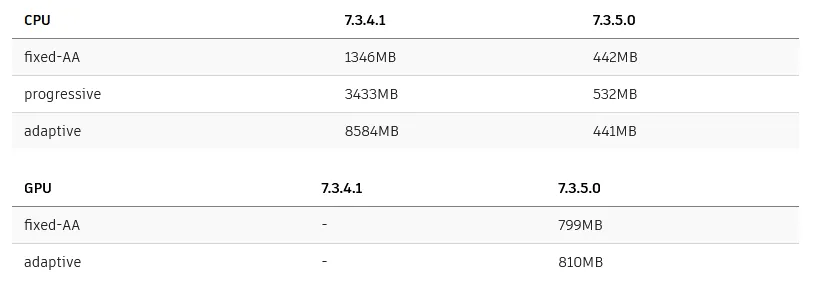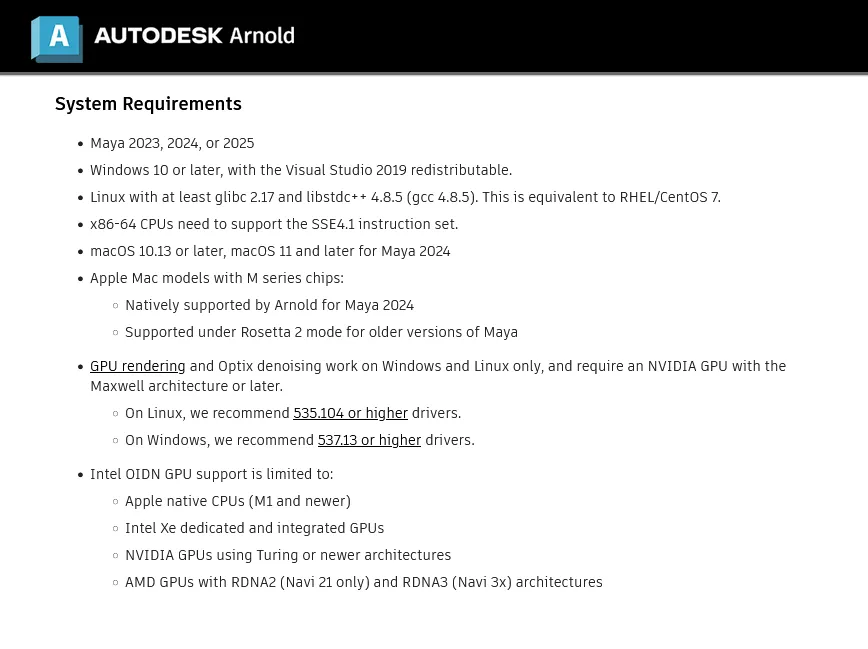

Software / Graphics & Design →Solid Angle Maya to Arnold 5.4.6 (x64)
Published by: voska89 on 11-11-2024, 14:58 |  0
0

Free Download Solid Angle Maya to Arnold 5.4.6 | 4.4 Gb
Solid Angle, a bussines Autodesk, is pleased to announce the availability ofArnold 5.4.6 for Autodesk Maya. This release uses Arnold 7.3.5.0 and is a minor feature release.
Owner:Solid Angle
Product Name:Arnold for Maya
Version:5.4.6
Supported Architectures:x64
Website Home Page :www.autodesk.com
Languages Supported:english
System Requirements:Windows, macOs & Linux *
Size:4.4 Gb
Enhancements
-New installer on macOS:The macOS installer works better with native macOS tools (MTOA-2051)
-Nits per Unit options parameter exposed:Introduced in Arnold 7.3.4.0, the OpenPBR Surface emission_luminance parameter (in nits) is scaled down by the nits_per_unit value (defaulting to 1000) to bring it into Arnold units (MTOA-2080)
-Exposed hydra parameter in mayaUSD proxy shape:usdProxyShape objects now have an Arnold section in the Attribute Editor, with several parameters. The new Hydra attribute allows you to render through the Hydra framework, and use Hydra generative procedurals. (MTOA-2130)
-Optimized Cryptomatte and GPU support:Arnold now has an internal implementation of Cryptomatte that adds support for GPUs and improves performance on CPU. Cryptomatte now consumes less memory for samples, making it easier to use higher AA settings, progressive rendering, and adaptive rendering (when properly used with FIS). In a simple scene rendered at 640x480 resolution with three cryptomattes the below table shows improvements in peak memory. (ARNOLD-11042)


Close
-Improved instancing in the alembic procedural:Instanced geometries are now better handled in Alembic. This fixes the known issues with make_instance, which is now enabled by default. (ARNOLD-15209, ARNOLD-8364, ARNOLD-8924, ARNOLD-7818)
-Faster OpenVDB volume intersection:Intersecting OpenVDB volumes are optimized for many-cores. Scenes where volume::intersection is a sizable component of render time can see large speedups. One scene where it accounted for 73% of render time on a 128-core machine saw the volume::intersection time drop to 16% of total time, for an overall 3x speedup in render time. (ARNOLD-15448)
-Faster uv_camera baking:The uv_camera.grid_size default is now 0 instead of 16, where 0 specifies that the grid_size is automatically chosen. Using the new default, baking a sphere with 800k triangles is now 6.5x faster than the previous default. (ARNOLD-15441)
-Add more options settings to image metadata:Images with metadata, such as EXR files, now include arnold/AA_samples_max, arnold/AA_adaptive_threshold, arnold/fis_filter, and arnold/fis_filter_width metadata. (ARNOLD-15521)
-[GPU] Support element linking of array parameters in ramp shaders:Arnold GPU now supports the linking of individual ramp parameter components for the position, value, color, and interpolation parameters. (ARNOLD-7120)
-OSL version 1.13.3.0:OSL has been upgraded to version 1.13.3.0. See OSL release notes for details. (ARNOLD-15319)
-MaterialX OSL closure support:the OSL closures defined by MaterialX (v1.38) for definition of layered physical materials have been ported to Arnold. For example, all the closures needed to implement the OpenPBR are now available in OSL. See OSL Shaders for more information
-Limit node update recursion:Previously, node updates were propagated up the parent chain for all node types. We now do this for shape nodes only. This can improve node update time. (ARNOLD-15492)
-Avoid unnecessary node updates:Resetting a node parameter to the current value will no longer cause a node update. (ARNOLD-15402)
-Per-parameter update dependencies:Previously, a node update dependency caused a node to be updated whenever the dependency node was modified. We now define these dependencies based on parameters, so the node update is triggered only when one of the specified parameters on the dependency node was modified. (ARNOLD-15483)
Incompatible Changes
-Missing dependencies:Custom nodes must declare all dependencies. Now that Arnold uses per-parameter dependencies, any missing dependencies will result in invalid data that may cause crashes or hangs. Also, shaders that depend on render camera values must declare a dependency on options.camera so that the shader is updated when a new camera is set. (ARNOLD-15483)
USD Enhancements
-Hydra mode in the usd procedural:A new parameter hydra can be used to render the USD data through a Hydra framework. This supports interactive updates, and can be used to reproduce the same behaviour as a Hydra render delegate (usd#2109 usd#2107 usd#2019 usd#2017 usd#2003)
-transform_keys primvar:When the primvar arnold:transform_keys is set, it controls the number of time samples used for the matrices of Arnold nodes (usd#2111)
-Arnold Cameras in Hydra:Arnold cameras (vr, cylindrical, spherical, uv, fisheye) are now supported in Hydra. You create the Arnold cameras as USD built-in cameras, with a string primvar arnold:camera that specifies the Arnold camera type. (usd#1738 usd#2082)
-Improved USD export that better supports Hydra:USD exports now support Hydra, so that scenes from Maya or 3ds Max now render as expected in Houdini Solaris.
. usd#2000 - Write light filters through node graphs so they can be rendered in Hydra
. usd#1965 - Write color manager attributes in the RenderSettings primitive
. usd#2008 - Write spot and photometric lights as UsdLux schemas
. usd#2030 - Write background and atmosphere shaders under a node graph for hydra support
. usd#2031 - Write AOV shaders under a node graph for hydra support
. usd#2025 - Write imagers through node graphs for hydra support
. usd#1987 - Author familyName and familyType in GeomSubsets written as USD
. usd#2080 - Author animated shader attributes in a way that they can render in hydra
. usd#2047 - Shaders exports should be bound to a material
-Fixed mismatches between USD and Hydra renders:Several changes were done, either on the procedural or the render delegate, in order to have a consistent behaviour in both code paths.
. usd#1974 - Delegate should only create default shaders when needed
. usd#1959 - Improve translation of normals and primvars in hydra
. usd#1946 - Support color space in materialx for hydra
. usd#2042 - Follow hydra normals skinning behavior in the procedural
. usd#2055 - Support animated curves orientations in hydra
. usd#2053 - Visibility and sidedness attributes not supported in Arnold native hydra prims
. usd#2061 - Support arnold light groups in Hydra
. usd#2086 - Compute FOV in the procedural and hydra in a similar manner
. usd#2057 - Add ginstance support in hydra and fix a data race issue
. usd#2067 - Do not author useless "normals" user data in meshes/curves through the procedural
. usd#2010 - Support TreatAsPoint in spot lights
. usd#1979 - Support treatAsPoint in Hydra photometric lights
-UsdPlane support:UsdPlane primitives were previously ignored, and are now rendered in Arnold. (usd#2058)
-Improved support for ArnoldProceduralCustom primitives:ArnoldProceduralCustom primitives are now supported like other geometric primitives, including instancing and visibility settings. (usd#2064)
-Profiling / Stats:Render settings can now specify filenames to output arnold profiling or stats files (usd#1118)
USD Bug Fixes
- usd#1982 - Fix subdivision when primvars are set in parent primitives
- usd#1997 - Apply correct amount of transform keys when xformOp is set on parent prims
- usd#1972 - Ensure subdivision is disabled when subdiv iterations is equal to 0 in Hydra
- usd#2015 - Support hydra points with empty widths
- usd#2084 - Imagers should be applied to all drivers
- usd#2105 - Ensure the Arnold scene isn't modified after a Hydra batch render started
- usd#1961 - Random curves width in Hydra when radius primvars are authored
- usd#1977 - AOV shaders not set properly in hydra mode of the scene format
- usd#1984 - Cylinder lights not taking normalization into account through USD
- usd#1994 - Fixed hydra errors with varying topologies, and incorrect velocities in first renders
- usd#1992 - Support hydra skinned positions with more than 3 keys
- usd#2027 - Fix faceVarying normals interpolation in the procedural when the mesh is left handed
- usd#1837 - Fix motion blur of instanced skinned geometry with animated parent matrix
- usd#2037 - Improve instances and objects motion blur coherence
- usd#2078 - Ensure the hydra render callback is always invoked
- usd#2094 - Support material interactive updates in the procedural
- usd#2092 - Fix interactive update issue when prims visibility is tweaked in the procedural
- usd#2102 - Remove hydra warning subdiv_iterations: use type BYTE, not INT
Arnoldis a physically-based, photo-realistic rendering tool that utilizes ray tracing techniques to produce high-quality renders for CG and VFX animation.Ray tracing is a mathematical algorithm (based on the Monte Carlo Path Tracing equation) that creates an image by projecting rays into a scene, reflecting them off surfaces and toward light sources to approximate the color value of pixels. Arnold utilizes computer hardware resources such as memory, multiple processor cores, and disk space to accomplish these tasks.
Arnold for Mayawas first conceived in Spain and coded by Marcos Fajardo, who co-developed it in collaboration with Sony Pictures Imageworks. Years after its creation, the well-known company Autodesk acquired the Arnold renderer in 2016. Since then, the software tool has evolved to function with different render engines and CAD software. Without Arnold, Maya was only capable of utilizing a single processor core at a time. This is why Arnold stands out as one of the fastest rendering tools available.
Creating Realistic Materials Using Arnold In Maya
In this Tutorial I'll show you guys how to Create Realistic Materials in Arnold for Maya, We Will taking a look at the different properties of the most frequently used materials and how to create them.
Solid Angleis leading provider of rendering software for animation and visual effects. The Arnold team believe that accurately and efficiently computing light transport in CG scenes is the best way to create stunning imagery for films and TV. Developers strive to provide clients with the best rendering tools to efficiently create realistic images. Solid Angle is a wholly owned subsidiary of Autodesk Inc, and has its offices in Madrid and London.

Buy Premium From My Links To Get Resumable Support,Max Speed & Support Me
Rapidgator
6tati.Solid-Angle-Maya-to-Arnold-5-4-6.part1.rar.html
6tati.Solid-Angle-Maya-to-Arnold-5-4-6.part2.rar.html
6tati.Solid-Angle-Maya-to-Arnold-5-4-6.part3.rar.html
TakeFile
6tati.Solid-Angle-Maya-to-Arnold-5-4-6.part1.rar.html
6tati.Solid-Angle-Maya-to-Arnold-5-4-6.part2.rar.html
6tati.Solid-Angle-Maya-to-Arnold-5-4-6.part3.rar.html
Fikper
6tati.Solid-Angle-Maya-to-Arnold-5-4-6.part1.rar.html
6tati.Solid-Angle-Maya-to-Arnold-5-4-6.part2.rar.html
6tati.Solid-Angle-Maya-to-Arnold-5-4-6.part3.rar.html
Links are Interchangeable - No Password - Single Extraction
Related News
-
{related-news}

